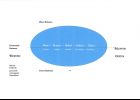Le diable, l’absurde et la philosophie / Extrait de L'Histoire du diable de Vilém Flusser: « La conversation »
This essay, a short introduction to the French translation of Vilém Flussers The History of the Devil, deals with some of the main aspects of the book, including the notion of sin and the figure of the devil, but also the dangers of nationalism, Marxism, the theoretical shortcomings of existentialism and Flusser’s interest in Buddhism. The accompanying extract from The History of the Devil, paragraph 6.4. Conversation, which is the last part of chapter 6. Envy and Greed, focuses on the notion of conversation, which is absolutely central to Flusser’s thinking. Its future ramifications extend to the concept of dialogue and go as far as the telematic society.
Die Dimension der Leere. Vedanta und Buddhismus in Vilém Flussers Das Zwanzigste Jahrhundert und Bodenlos
This short essay explores some of the connections between Vilém Flusser’s study of eastern philosophy in the 1940s and 1950s and his later notion of zero dimensionality. In his first book, Das Zwanzigste Jahrhundert, he pointed to a theoretical convergence between the Indian Vedanta, Buddhism and modern natural sciences. In his autobiography, Bodenlos, written in the early 1970s Flusser reevaluated his former interest in oriental philosophy in highly critical terms. However, despite this attempt at distancing, some of the notions from Das Zwanzigste Jahrhundert infiltrated his late vision of an emerging universe of technical images.
„Ich habe gegen Pathos zu kämpfen gehabt […].“ Zur Entstehung und Bedeutung von Vilém Flussers Das Zwanzigste Jahrhundert. Versuch einer subjektiven Synthese
This essay deals with Vilém Flusser’s first finished, but still unpublished book Das Zwanzigste Jahrhundert, which was most probably written in the mid-1950s. The book consists of six chapters linked to each other in an unfolding spiral: politics, society, science, art, philosophy and religion. Flusser’s main aim is to try to synthesize the West with the East: modern Western science with the Indian philosophy of the Vedanta, the contemporary Western concept of art with that of Chinese culture and the Judaic-Christian belief with Hinduism and Buddhism. This synthesis is possible because the West and the East have been slowly evolving in the same direction. The book is remarkable both from a thematic and a stylistic point of view. It is the very origin, and construction site of Flusser’s work to come. Flusser has discarded some of the ideas put forward in Das Zwanzigste Jahrhundert, but retained many others transforming them over the course of the years. Furthermore, Das Zwanzigste Jahrhundert allows a reflection on the origins of Flusser’s writing, and on the development of his style.


